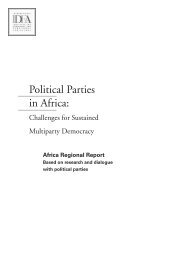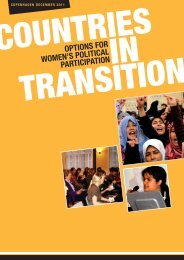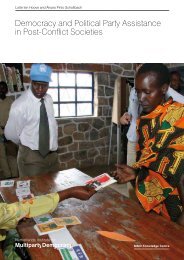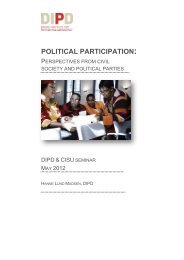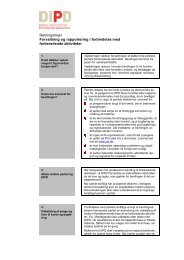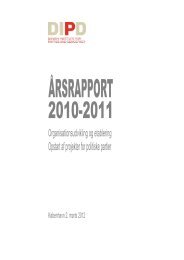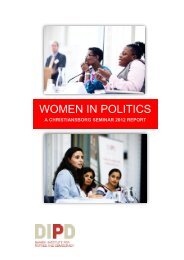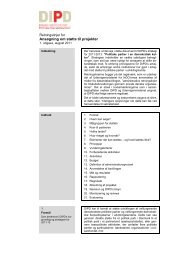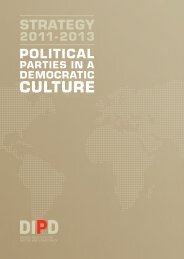Background Document - Danish Institute for Parties and Democracy
Background Document - Danish Institute for Parties and Democracy
Background Document - Danish Institute for Parties and Democracy
You also want an ePaper? Increase the reach of your titles
YUMPU automatically turns print PDFs into web optimized ePapers that Google loves.
Generally speaking, developments are uneven, particularly <strong>for</strong> the first fifty years,<br />
which are characterised by long periods of stagnation broken by some notable <strong>for</strong>ward<br />
leaps in the early 1940s <strong>and</strong> again in the early 1970s.<br />
The representation of women in Parliament thus falls into three phases, which<br />
mirror the general situation when it comes to equal status policy.<br />
1915-1945 with less than 5 % female representation.<br />
1945-1971 with a female representation of up to 10%.<br />
1971-2011 with a rapid <strong>and</strong> sustained growth in female representation towards the<br />
40% mark.<br />
The first phase ends with the close of the Second World War, when a great window<br />
of opportunity opened up in equal rights policy, as is often the case in post-crisis situations.<br />
Across the world, women had made a significant contribution during the war<br />
years, both on the home front <strong>and</strong> in the field.<br />
Recognition of this contribution came in several <strong>for</strong>ms. Equal gender rights were<br />
included in international legislation through the United Nations Charter <strong>and</strong> the Universal<br />
Declaration of Human Rights. The political representation of women increased<br />
in countries with women’s suffrage, including Denmark, <strong>and</strong> having a female government<br />
minister became a must. Other countries, including, as previously mentioned,<br />
France, instituted voting rights <strong>for</strong> women.<br />
The second phase ends with the beginning of the second feminist wave in the<br />
wake of the 1960s youth rebellions. The 1970s became the women’s decade par excellence,<br />
not least due to the United Nations’ prominent focus on equal rights, including<br />
the International Women’s Year, the World Conference on Women, <strong>and</strong> a bill of rights<br />
<strong>for</strong> women: the Convention on the Elimination of all Forms of Discrimination against<br />
Women (CEDAW).<br />
In Denmark, women charged into parliament, where the percentage of women<br />
surged from eleven to twenty-four per cent over the course of the 1970s. And in a new<br />
development, women’s political representation continued to increase. Following the<br />
long period of stagnation, focus shifted from political rights to political participation,<br />
<strong>and</strong> the feminist tenet that political organs not having an equal gender distribution<br />
are illegitimate now garnered broad popular support.<br />
Revolutions are created by the assault of youth on old regimes, <strong>and</strong> the second<br />
feminist wave became the historical youth rebellion of women. In earlier days, female<br />
politicians were typically middle-aged, because they did not run <strong>for</strong> office until the<br />
children were out of the house. Since the mid-1960s, the mean age <strong>for</strong> women in Parliament<br />
has dropped by ten years, from fifty-five to <strong>for</strong>ty-five, <strong>and</strong> the age composition<br />
has become more diverse. The latest national elections gave seats in Parliament<br />
to two women between the ages of twenty <strong>and</strong> twenty-four, <strong>and</strong> two between the ages<br />
of sixty <strong>and</strong> sixty-nine.<br />
“The entire female elite in the country was<br />
mobilised in a large-scale media push.”<br />
The young women brought the issues of pregnancy, birth, <strong>and</strong> parental leave with<br />
them into political life. When the first pregnant woman ran <strong>for</strong> Parliament in 1971,<br />
<strong>and</strong> was elected, it made the headlines. Front pages were cleared again when the first<br />
female minister gave birth while in office in 1998. Since then, many have followed in<br />
their footsteps, <strong>and</strong> today nobody disputes female politicians’ right to have children<br />
while holding office.<br />
WOMEN IN POLITICS DANISH INSTITUTE FOR PARTIES AND DEMOCRACY PAGE 52



